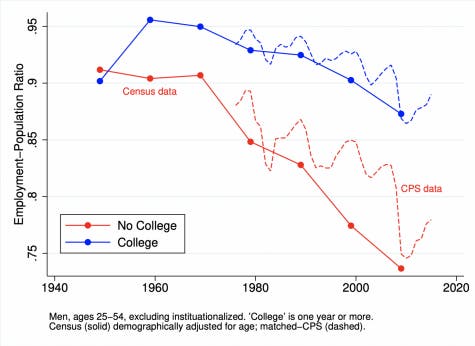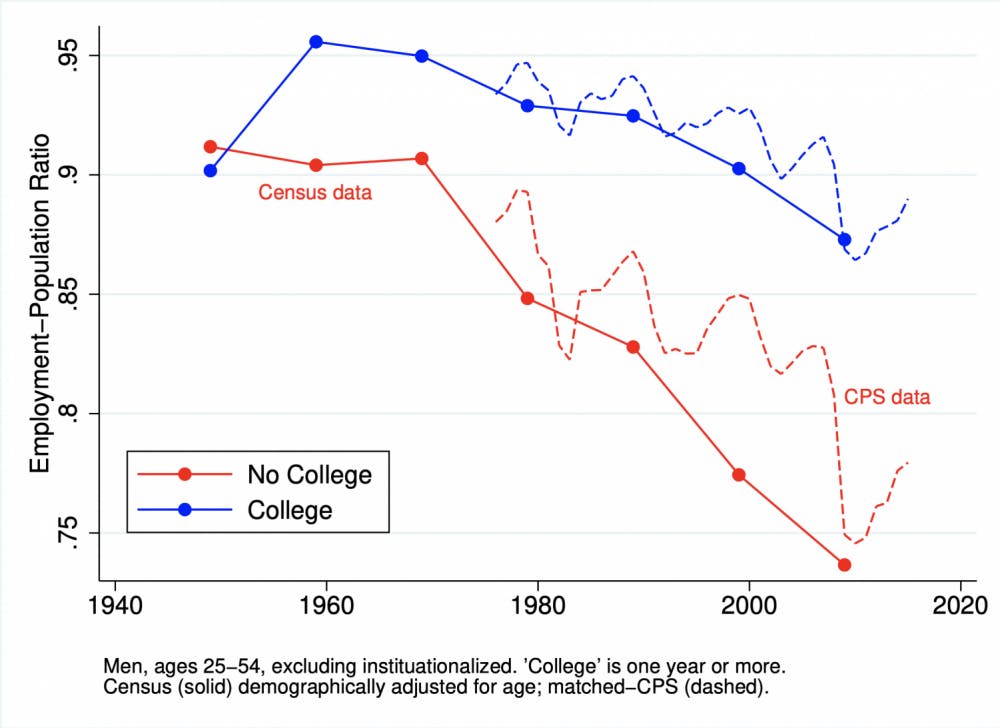We’ve all been there — sitting hunched over your desk at an ungodly hour in the night, cramming for the second of three midterms that week, probably thinking: “I quit college.”
Today, some of the richest and most famous people in the world do not hold college degrees: Michael Dell, Beyoncé, Oprah Winfrey. These are three compelling arguments for why it might be better to skip college, eschew $140K in tuition and spend your time building the next Facebook. For those of us who have regretted our decision to go to college or thought about dropping out, know that Assistant Professor of Economics Erin Wolcott has done research on this very idea. While her research doesn’t “direct people to college or not to college,” it does say something about the current population that does not go to college and what they’re doing (or not doing) afterwards.
According to the most recent American Community Survey in 2016, more than one out of every five men who do not attend college — about 7.1 million individuals — do not have jobs. In other words, only 78% of this population is employed, compared to 90% in the 1950s. Why is there such a high rate of nonemployment — which includes both unemployed people who are actively seeking jobs and those who are not — for men without a college education? To answer this question, Wolcott looked at different causes of unemployment in America.
Supply and demand is the first concept we learn in economics; it illustrates the relationship between how much producers sell and how much consumers buy. Everything can be linked back to supply and demand. In the labor market, demand side factors affect how much businesses and employers are hiring (their demand for labor), as these factors transform what jobs are available and who is doing them. Wolcott’s 2018 paper highlights the most common economic explanation regarding demand: “automation and trade reduce[s] the demand for low-skilled workers.”
Consider the General Motors (GM) and United Automobile Workers (UAW) strike, which lasted six weeks as company and workers negotiated wages and job security. GM workers feared for their jobs as the company made plans to close another factory and outsource to Mexico, where workers would provide the same labor for mere dollars. UAW workers are also fighting for security; since 1975, the number of UAW employees has dropped from 1.5 million to 400,000, as tech decreased the need for assembly line workers.

Supply side factors, on the other hand, affect who enters the job market (the supply of workers). Wolcott writes: “Economists have traditionally pointed the finger at [demand-side factors]. More recently, economists have been blaming the supply side, such as growing welfare payments and better video games that glue more men to their couches.” True, video games are vastly improving – take Fortnite as an example, which amassed over 4.3 million concurrent viewers on YouTube during its explosive Season 10 finale. Does this mean that unskilled men prefer to sit at home and play Fortnite all day than to get a job? Or examining the other supply-side culprit, unemployment benefits — maybe it is more profitable to get welfare and disability insurance.
The last factor causing nonemployment are search frictions, which make it difficult to match the workforce with available jobs. An example of a search friction? Online job postings. As college students, LinkedIn, Handshake and Indeed.com can make it easier to find jobs. Many older or uneducated adults, however, may not know how to use these sites, making it harder for them to find jobs.
So, we have three possibilities for why one of five uneducated men aren’t getting hired: (1) society isn’t demanding these populations (demand), (2) they don’t want to work (supply) and (3) new tech and resources are making it difficult to find work.
In her research, Wolcott built an economic model using employment, wage and other relevant data to encompass the three explanations for nonemployment to explore the extent of this causal relationship. She points to demand side factors — mainly tech and globalization — as the most significant reason for why so many unskilled men in America aren’t working: “It’s not because they’re choosing to play video games on average over a great job opportunity but because there aren’t job opportunities.”
“This is the first step to understand what’s going on,” Wolcott said.
Inequality is on the rise in America, breeding resentment and political polarity, and it is important to understand why. The next step is to start thinking about policies. While we aren’t about to become Luddites or stop global trade, economists have identified ways to bring people back into the job market, starting with education. Whether this will be making education cheaper, promoting vocational schools and apprenticeships or offering direct subsidies for specific institutions or courses, there are a myriad of potential solutions that will help make the labor market more inclusive and equal and bring millions back into the workforce.
Unpacking unemployment: Wolcott on the U.S. job market

COURTESY PHOTO/ERIN WOLCOTT
Comments



